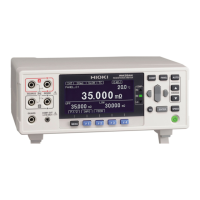Operating Precautions
7
Handling the Instrument
• Do not allow the instrument to get wet, and do not take measurements
with wet hands. This may cause an electric shock.
• Do not attempt to modify, disassemble or repair the instrument; as
fire, electric shock and injury could result.
• To avoid damage to the instrument, protect it from physical shock when
transporting and handling. Be especially careful to avoid physical shock
from dropping.
• To avoid damage to the instrument, do not apply voltage or current to mea-
surement terminals, TEMP.SENSOR jack, or COMP.OUT jack.
• This instrument may cause interference if used in residential areas. Such
use must be avoided unless the user takes special measures to reduce
electromagnetic emissions to prevent interference to the reception of radio
and television broadcasts.
• Use the original packing materials when transporting the instrument, if pos-
sible.
Handling the Cords and Leads
To avoid electrical shock, be careful to avoid shorting live lines with the
test leads.
• Avoid stepping on or pinching cables, which could damage the cable insula-
tion.
• To avoid breaking cables or lead wires, do not bend or pull them.
• To avoid damaging the power cord, grasp the plug, not the cord, when
unplugging it from the power outlet.
• To avoid damaging the cable, grasp the connector, not the cable, when
unplugging the cable.
• The ends of the pin type lead are sharp. Be careful to avoid injury.
• Keep the cables well away from heat sources, as bare conductors could be
exposed if the insulation melts.
• Temperature sensors are precision devices. Be aware that excessive volt-
age pulses or static discharges can destroy the film.
• Avoid subjecting the temperature sensor tip to physical shock, and avoid
sharp bends in the leads. These may damage the probe or break a wire.

